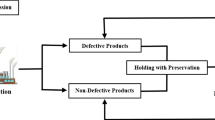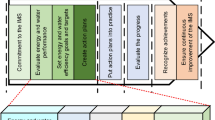Abstract
A growing number of manufacturing firms are striving to achieve eco-friendly operations through onsite wind or solar generation. This paper proposes a zero-carbon power supply model to guide the integration of onsite renewable energy into manufacturing facilities. We intend to address two fundamental questions: (1) Is it cost-effective to deploy onsite wind turbines and solar photovoltaics (PVs) systems to achieve net-zero carbon environmental performance? (2) Is the renewable generation system able to meet the electricity demand despite the power intermittency? To answer these questions, we formulate a stochastic optimization model to minimize the levelized cost of onsite renewable energy. The goal is achieved by optimizing the sizing of wind and solar generating units. The proposed energy solution is tested in ten cities around the world under diverse climatic conditions. While PV is still expensive, we conclude that manufacturers could realize zero-carbon emissions at affordable cost provided the local wind speed is above 5 m/s.







Similar content being viewed by others
References
Aalami HA, Moghaddam MP and Yousefi GR (2010). Demand response modeling considering interruptible/curtailable loads and capacity market programs. Applied Energy 87(1):243–250.
Aflaki S, Kleindorfer PR and de Miera Polvorinos SV (2013). Finding and implementing energy efficiency projects in industrial facilities. Production and Operations Management 22(3):503–517.
Apple, Inc. (2012). Powering Our Facilities with Clean and Renewable Energy. Available at http://www.apple.com/environment/renewable-energy/. Accessed 4 Feb 2014.
Baldick R, Kolos S and Tompaidis S (2006). Interruptible electricity contracts from an electricity retailer’s point of view: Valuation and optimal interruption. Operations Research 54(4):627–642.
Benjaafar S, Li Y and Daskin M (2013). Carbon footprint and the management of supply chains: Insights from simple models. IEEE Transactions on Automation Science Engineering 10(1):99–116.
Cai T, Duan S and Chen C (2010). Forecasting power output for photovoltaic grid-connected power systems without using solar radiation measurement. In Proceedings of Power Electronics for Distributed Generation Systems Symposium, June 16–18, Hefei, China, pp. 773–777.
Celli G, Ghaiani E, Mocci S and Pilo F (2005). A multiobjective evolutionary algorithm for the sizing and siting of distributed generation. IEEE Transactions on Power Systems 20(2):47–55.
Choi Y and Xirouchakis P (2014). A production planning in highly automated manufacturing system considering multiple process plans with different energy requirements. The International Journal of Advanced Manufacturing Technology 70(5–8):853–867.
Eberling B (2013). Fairfield brewery gets mammoth wind turbine to power plant. Available at http://www.dailyrepublic.com/featured-stories/fairfield-brewery-gets-mammoth-wind-turbine-to-power-plant. Accessed January 19, 2014.
Energy Star (2012). Harmonizing Global Metrics for Data Center Energy Efficiency. Available at http://www.energystar.gov/buildings/sector-specific-resources/data-center-resources. Accessed December 31, 2014.
EPA (2015). Renewable Energy Certificates (REC). Available at http://www.epa.gov/greenpower/gpmarket/rec.htm. Accessed June 10, 2015.
Floudas CA and Pardalos PM (1992). Recent Advances in Global Optimization. Princeton University Press: Princeton, NJ.
Freris L and Infield D (2008). Renewable Energy in Power Systems, Chapter 7. Wiley: Chichester, West Sussex.
Haghifam M-R, Falaghi H and Malik OP (2008). Risk-based distributed generation placement. IET Generation, Transmission and Distribution 2(2):252–260.
Hurrion RD (1997). An example of simulation optimisation using a neural network metamodel: Finding the optimum number of kanbans in a manufacturing system. Journal of the Operational Research Society 48(10):1105–1112.
Ierapetritou MG, Wu D, Vin J, Sweeny P and Chigirinskiy M (2002). Cost minimization in an energy-intensive plant using mathematical programming approaches. Industrial and Engineering Chemistry Research 41(21):5262–5277.
Jangamshetti SH and Rau VG (2001). Normalized power curves as a tool for identification of optimum wind turbine generator parameters. IEEE Transactions on Energy Conversion 16(3):283–288.
Jin T, Yu Y and Elsayed E (2015). Reliability and quality control for distributed wind–solar energy integration: A multi-criteria approach. IIE Transactions 47(10):1122–1138.
Justus CG, Hargraves WR, Mikhai A and Graber D (1978). Methods for estimating wind speed frequency distribution. Journal of Applied Meteorology 17(3):350–353.
Karki R, Hu P and Billinton R (2006). A simplified wind power generation model for reliability evaluation. IEEE Transaction on Energy Conversion 21(2):533–540.
Karwan MH and Keblis MF (2007). Operations planning with real time pricing of a primary input. Computers & Operations Research 34(3):848–867.
King AA and Lenox MJ (2001). Lean and green? An empirical examination of the relationship between lean production and environmental performance. Production and Operations Management 10(3):244–256.
Kleindorfer PR, Singhal K and Van Wassenhove LN (2005). Sustainable operations management. Production and Operations Management 14(4):482–492.
Lave M and Kleissl J (2011). Optimum fixed orientations and benefits of tracking for capturing solar radiation. Renewable Energy 36(3):1145–1152.
Li L and Sun Z (2013). Dynamic energy control for energy efficiency improvement of sustainable manufacturing systems using Markov decision process. IEEE Transactions on Systems, Man and Cybernetics: Systems 43(5):1195–1205.
Mitra S, Grossmann IE, Pinto JM and Arora N (2012). Optimal production planning under time-sensitive electricity prices for continuous power-intensive processes. Computer and Chemical Engineering 38(5):171–184.
Moon J-Y and Park J (2014). Smart production scheduling with time-dependent and machine-dependent electricity cost by considering distributed energy resources and energy storage. International Journal of Production Research 52(13):3922–3939.
Moore FC and Diaz DB (2015). Temperature impacts on economic growth warrant stringent mitigation policy. Nature Climate Change 5(2):127–131.
Mouzon G, Yildirim MB and Twomey J (2007). Operational methods for minimization of energy consumption of manufacturing equipment. International Journal of Production Research 45(18–19):4247–4271.
National Climate Data Center (NCDC) (2014). Available at http://www.ncdc.noaa.gov/. Accessed December 10, 2014.
National Renewable Energy Laboratory (NREL) (2013). Distributed Generation Renewable Energy Estimate of Costs. Available at http://www.nrel.gov/analysis/tech_lcoe_re_cost_est.html. Accessed May 7, 2015.
Paksoy T and Özceylan E (2013). Environmentally conscious optimization of supply chain networks. Journal of the Operational Research Society 65(2):855–872.
Plambeck E (2012). Reducing greenhouse gas emissions through operations and supply chain management. Energy Economics 34(Supplement 1, no 11):S64–S74.
Santana-Viera V, Jimenez J, Jin T and Espiritu J (2015). Implementing factory demand response with onsite renewable energy: A design-of-experiment approach. International Journal of Production Research 53(23):7034–7048.
Taboada H, Xiong Z, Jin T and Jimenez J (2012). Exploring a solar photovoltaic-based energy solution for green manufacturing industry. In Proceedings of the IEEE Conference on Automation Science and Engineering, August 20–24, Seoul, Korea, pp. 40–45.
Villarreal S, Jimenez J, Jin T and Cabrera-Rios M (2013). Designing a sustainable and distributed generation system for semiconductor wafer fabs. IEEE Transactions on Automation Science and Engineering 10(1):10–16.
Weather Underground (WU) (2014). Available at http://www.wunderground.com/. Accessed November 10, 2014.
Wiser R and Bolinger M (2008). Annual Report on U.S. Wind Power Installation, Cost, Performance Trend: 2007. Technical Report, U.S. Department of Energy: Washington, DC.
Acknowledgements
The research is supported in part by the U.S. Department of Agriculture (# 2011-38422-30803), and in part by The National Natural Science Fund of China (#71172162).
Author information
Authors and Affiliations
Corresponding author
Appendices
Appendix A
Modeling wind power generation
Let V be the random wind speed at time t, and v be its realization. The instantaneous output power of a WT, denoted as P w(v), can be modeled by the following cubic function (Jangamshetti and Rau, 2001)
where P m is the WT capacity. Note that v c is the cut-in speed, v r is the rated speed, and v s is the cut-off speed. It has been shown that wind speed in a particular area can be fit by either Weibull or normal distributions (Justus et al, 1978; Karki et al, 2006). The two-parameter Weibull distribution function is given as
where c w and d w are the scale and the shape parameters, respectively. Equation (A.2) allows us to simulate the hourly wind speed. The relations between c w and d w and the mean and the variance of wind speed are governed by the following equations (Justus et al, 1978),
where Γ(·) is the gamma function, and μ w and \(\sigma_{\text{w}}^{2}\) are the mean and the variance of wind speed. Once the yearly wind speed data are obtained, both μ w and \(\sigma_{\text{w}}^{2}\) can be estimated. Through Equations (A.3) and (A.4), the values of c w and d w are also known.
Appendix B
Modeling solar PV generation
Below we review the clear-sky PV generation model. Factors that have a major influence on the PV generation is summarized in Table A1. Note that the unit of the angles is rad.
We present a three-step procedure to calculate the hourly PV generation based on the studies in Cai et al (2010) and Taboada et al (2012). These steps are summarized as follows.
-
Step 1: Compute the sunrise and sunset time for day d ∈ {1, 2,…,365}
$$\cos \left( { - \omega_{\text{rise}} } \right) = \cos \left( {\omega_{\text{set}} } \right) = \tan (\phi - \beta )\tan \delta ,$$(B.1)with
$$\delta = 0.40928\sin \left( {\frac{2\pi (d + 284)}{365}} \right),$$(B.2)where δ is the solar declination angle, ω rise and ω set are the sunrise and the sunset angles in day d perceived from the PV panel. There is no PV output when ω < ω rise or ω > ω set, i.e., before sunrise or after subset.
-
Step 2: Calculate the total amount of solar irradiance incident on the PV surface in a particular hour of a day
$$I_{t} = 1370\left( {0.7^{{(\cos \varphi )^{ - 0.678} }} } \right)\left( {1 + 0.034\cos \left( {\frac{2\pi (d - 4)}{365}} \right)} \right) \times \left( {\cos \theta + 0.1\left( {1 - \frac{\beta }{\pi }} \right)} \right).$$(B.3)With
$$\cos \varphi = \cos \delta \cos \phi \cos \omega + \sin \delta \sin \phi ,$$(B.4)$$\begin{aligned} \cos \theta & = \sin \delta \sin \phi \cos \beta - \sin \delta \cos \phi \sin \beta \cos \alpha + \cos \delta \cos \phi \cos \beta \cos \omega \\ & \quad + \cos \delta \sin \phi \sin \beta \cos \alpha \cos \omega + \cos \delta \sin \alpha \sin \omega \sin \beta , \\ \end{aligned}$$(B.5)where, I t is the solar irradiance (W/m2) received by the PV at time t on day d. Here φ is the solar zenith angle which is given by Equation (B.4), and ω is the solar hour angle determined by the local hour t. For instance ω = −π/2 at 6 AM in the morning, and it increases 15° every hour until reaching ω = π/2 at 6 PM in the evening.
-
Step 3: By incorporating the weather uncertainty, the actual output power of a PV system in hour t on day d, denoted as P t in watts (W), can be estimated as
$$P{}_{t} = W_{t} \eta AI_{t} \left( {1 - 0.005\left( {T_{\text{o}} - 25} \right)} \right),$$(B.6)where W t is a random variable representing the stochastic weather condition at time t of day d. Typical values for W t are 0.9, 0.7, and 0.3, representing a clear, a partly cloudy, and an overcast day, respectively (Lave and Kleissl, 2011).
Rights and permissions
About this article
Cite this article
Li, B., Tian, Y., Chen, F. et al. Toward net-zero carbon manufacturing operations: an onsite renewables solution. J Oper Res Soc 68, 308–321 (2017). https://doi.org/10.1057/s41274-016-0014-5
Received:
Accepted:
Published:
Issue Date:
DOI: https://doi.org/10.1057/s41274-016-0014-5




